Search
- Page Path
-
- HOME
- Search
- Review Article
- Nephrology (Genitourinary)
- Kidney complications associated with COVID-19 infection and vaccination in children and adolescents: a brief review
- Hee Sun Baek, Min Hyun Cho
- Clin Exp Pediatr. 2023;66(10):424-431. Published online June 28, 2023
-
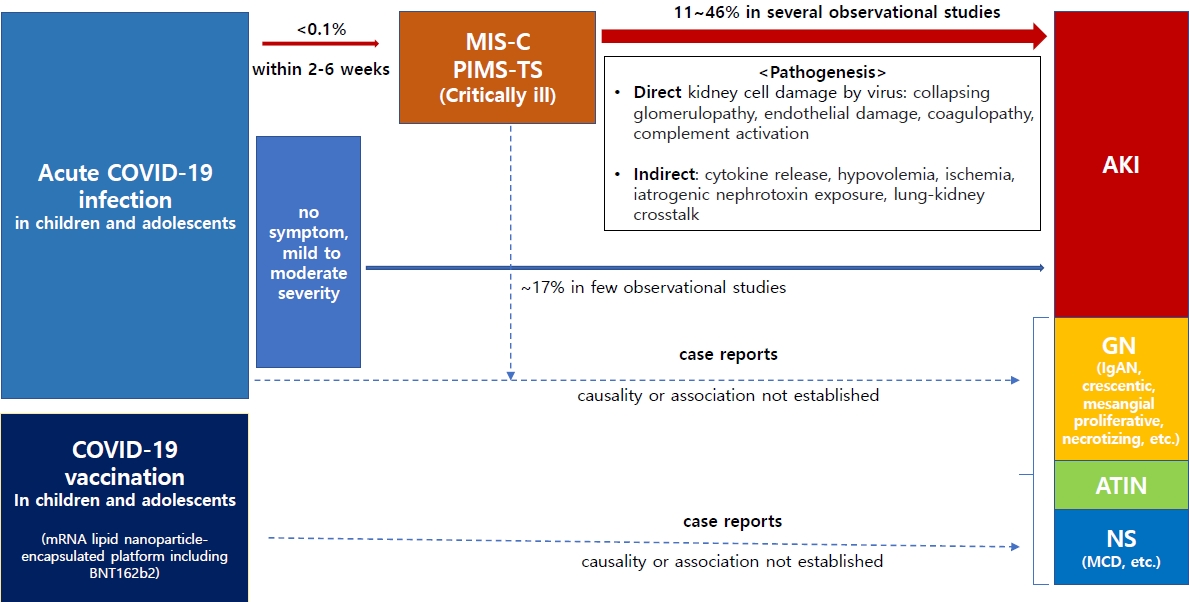
Several observational studies have shown that acute kidney injury affects up to 46% of children and adolescents who develop severe postinflammatory responses, such as multisystem inflammatory syndrome in childhood, due to coronavirus disease 2019 (COVID-19). Although causality has not been established, some cases of glomerulopathy or nephrotic syndrome occurring after COVID-19 infection or vaccination have been reported. Therefore, kidney complications associated with these conditions in children and adolescents warrant attention.
- Neurobehavior
- Psychological aspects in children and parents of children with chronic kidney disease and their families
- Alemsungla Aier, Priya Pais, Vijaya Raman
- Clin Exp Pediatr. 2022;65(5):222-229. Published online November 10, 2021
-
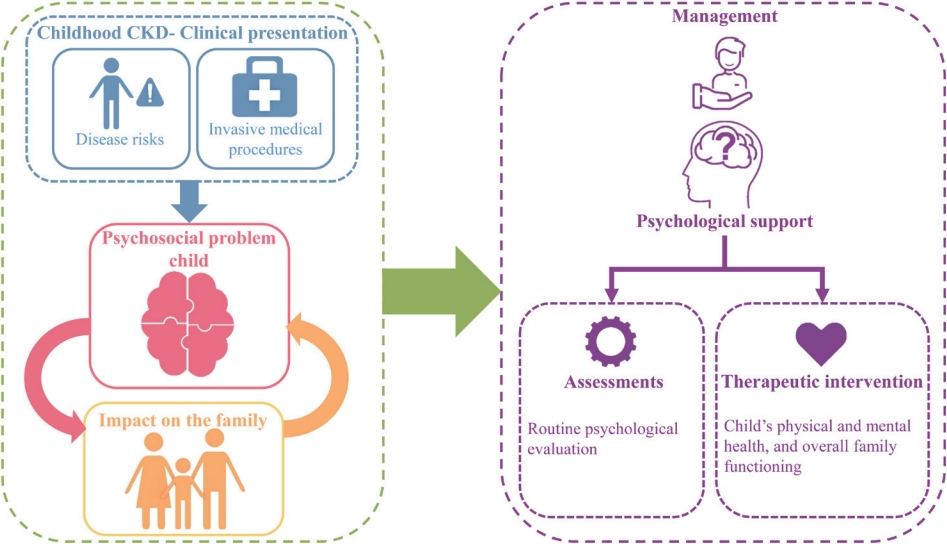
· Childhood chronic kidney disease (CKD) is complex and requires lifetime medical treatment.
· Children with CKD are at risk for emotional, behavioral, social, and academic difficulties that significantly affect their quality of life.
· Caring for children with CKD is stressful for families.
· These unique challenges are crucial and can negatively impact treatment outcomes.
· Awareness of and addressing these evolving psychosocial issues can foster their developing needs.
- Original Article
- Nephrology (Genitourinary)
- Variation in clinical usefulness of biomarkers of acute kidney injury in young children undergoing cardiac surgery
- Hee Sun Baek, Youngok Lee, Hea Min Jang, Joonyong Cho, Myung Chul Hyun, Yeo Hyang Kim, Su-Kyeong Hwang, Min Hyun Cho
- Clin Exp Pediatr. 2020;63(4):151-156. Published online February 5, 2020
-
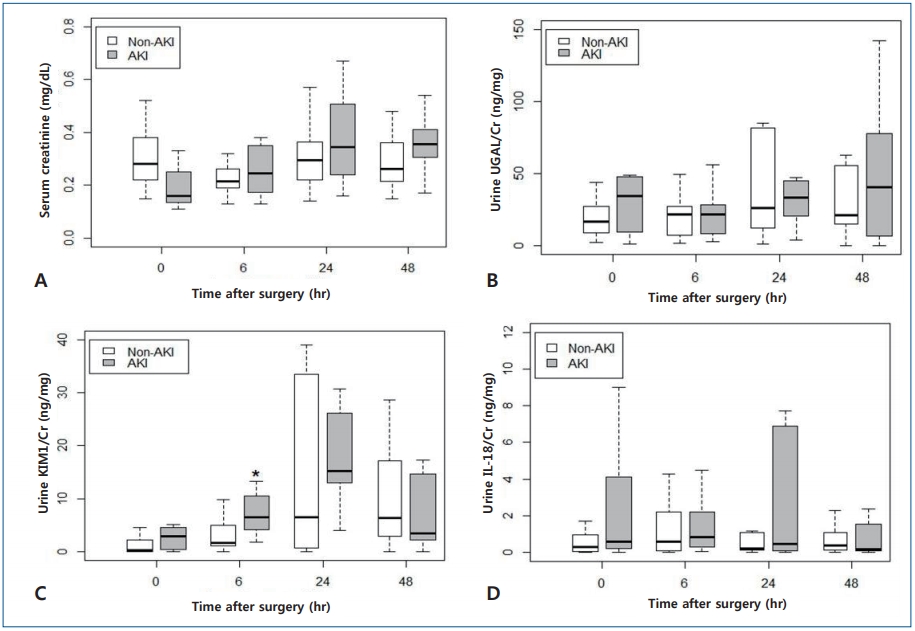
Question: Can clinical usefulness of biomarkers of acute kidney injury vary on the clinical circumstances?
Finding: In young children undergoing cardiac surgery, urine KIM-1/Cr level peaked at 24 hours with significant difference from baseline level and was significantly higher at 6 hours in the AKI group. However, urine NGAL/Cr and IL-18/Cr levels showed no specific trend with time for 48 hours after cardiac surgery.
Meaning: Urine KIM-1/Cr concentration could be considered a good biomarker for early AKI prediction after open cardiac surgery in young children.
- Review Article
- Nephrology (Genitourinary)
- Reconsideration of urine culture for the diagnosis of acute pyelonephritis in children: a new challenging method for diagnosing acute pyelonephritis
- Jun Ho Lee, Seonkyeong Rhie
- Clin Exp Pediatr. 2019;62(12):433-437. Published online October 18, 2019
-
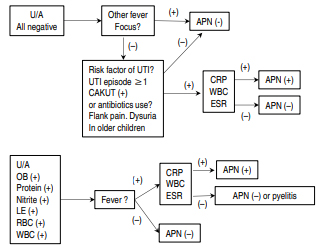
Acute pyelonephritis (APN) should be detected and treated as soon as possible to reduce the risk of the development of acquired renal scarring. However, in the medical field, urine culture results are not available or considered when the prompt discrimination of APN is necessary and empirical treatment is started. Furthermore, urine culture cannot discriminate APN among children with febrile urinary...
- Original Article
- Nephrology (Genitourinary)
- Clinical manifestations of BK virus infection in pediatric kidney transplant patients
- Yiyoung Kwon, Jeong Yeon Kim, Yeonhee Lee, Heeyeon Cho
- Clin Exp Pediatr. 2019;62(11):422-427. Published online September 5, 2019
-

Background: Polyomavirus BK (BKV) infection is an important cause of graft loss in kidney transplant patients.
Purpose: The purpose of this study was to evaluate clinical findings and risk factors for BKV in pediatric patients after kidney transplantation. Methods: This retrospective single-center study included 31 pediatric kidney transplant recipients from January 2002 to December 2017. Two patients received 2 transplantations during the...
- Review Article
- Nephrology (Genitourinary)
- Acute kidney injury and continuous renal replacement therapy in children; what pediatricians need to know
- Myung Hyun Cho, Hee Gyung Kang
- Clin Exp Pediatr. 2018;61(11):339-347. Published online October 23, 2018
-
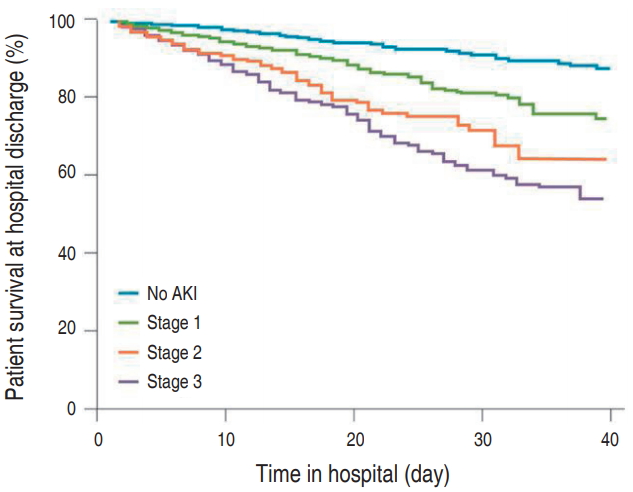
Acute kidney injury (AKI) is characterized by abrupt deterioration of renal function, and its diagnosis relies on creatinine measurements and urine output. AKI is associated with higher morbidity and mortality, and is a risk factor for development of chronic kidney disease. There is no proven medication for AKI. Therefore, prevention and early detection are important. Physicians should be aware of...
- Original Article
- Nephrology (Genitourinary)
- Renal involvement in children and adolescents with inflammatory bowel disease
- Hea Min Jang, Hee Sun Baek, Jung-Eun Kim, Ju Young Kim, Yeon Hee Lee, Hee Yeon Cho, Yon Ho Choe, Ben Kang, Byung-Ho Choe, Bong Seok Choi, Min Hyun Cho
- Clin Exp Pediatr. 2018;61(10):327-331. Published online September 12, 2018
-

Purpose: The incidence of inflammatory bowel disease (IBD) is rapidly increasing, and several reports have described the renal complications of IBD. We sought to evaluate the clinical manifestations of renal complications in children with IBD in order to enable early detection and prompt treatment of the complications. Methods: We retrospectively reviewed the medical records of 456 children and adolescents aged <20...
- Review Article
- Nephrology (Genitourinary)
- Pediatric kidney transplantation is different from adult kidney transplantation
- Min Hyun Cho
- Clin Exp Pediatr. 2018;61(7):205-209. Published online July 15, 2018
-
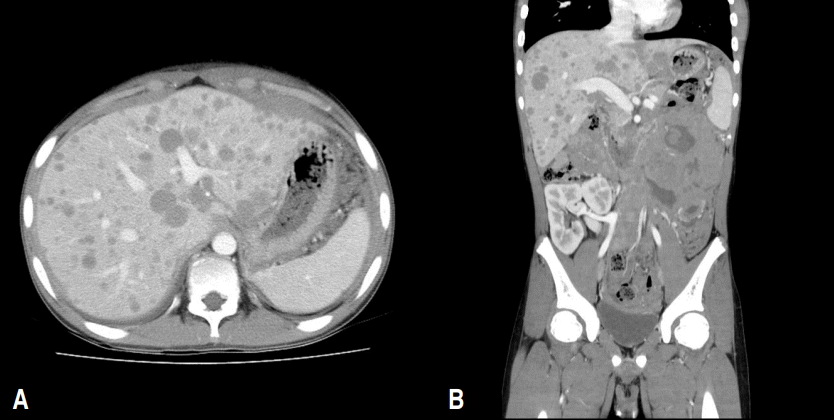
Kidney transplantation (KT) is the gold standard for renal replacement therapy in pediatric patients with end-stage renal disease. Recently, it has been observed that the outcome of pediatric KT is nearly identical to that in adults owing to the development and application of a variety of immunosuppressants and newer surgical techniques. However, owing to several differences in characteristics between children... -
DOI: https://doi.org/10.3345/kjp.2018.61.7.205 Correction in: Clin Exp Pediatr 2018;61(8):264
- Original Article
- Nephrology (Genitourinary)
- Acute kidney injury in pediatric patients with rhabdomyolysis
- Young Shin Lim, Heeyeon Cho, Sang Taek Lee, Yeonhee Lee
- Clin Exp Pediatr. 2018;61(3):95-100. Published online March 19, 2018
-
Purpose This study aimed to evaluate the clinical findings in pediatric rhabdomyolysis and the predictive factors for acute kidney injury (AKI) in Korean children.
Methods Medical records of 39 Korean children, who were newly diagnosed with rhabdomyolysis from January 2008 to December 2015, were retrospectively analyzed. The diagnosis was made from the medical history, elevated serum creatinine kinase level >1,000 IU/L, and plasma...
- Case Report
- Nephrology (Genitourinary)
- Deficiency of antidiuretic hormone: a rare cause of massive polyuria after kidney transplantation
- Kyung Mi Jang, Young Soo Sohn, Young Ju Hwang, Bong Seok Choi, Min Hyun Cho
- Clin Exp Pediatr. 2016;59(4):202-204. Published online April 30, 2016
-
A 15-year-old boy, who was diagnosed with Alport syndrome and end-stage renal disease, received a renal transplant from a living-related donor. On postoperative day 1, his daily urine output was 10,000 mL despite normal graft function. His laboratory findings including urine, serum osmolality, and antidiuretic hormone levels showed signs similar to central diabetes insipidus, so he was administered desmopressin acetate...
- Original Article
- Nephrology (Genitourinary)
- Acute tubular necrosis as a part of vancomycin induced drug rash with eosinophilia and systemic symptoms syndrome with coincident postinfectious glomerulonephritis
- Kyung Min Kim, Kyoung Sung, Hea Koung Yang, Seong Heon Kim, Hye Young Kim, Gil Ho Ban, Su Eun Park, Hyoung Doo Lee, Su Young Kim
- Clin Exp Pediatr. 2016;59(3):145-148. Published online March 31, 2016
-
Drug rash with eosinophilia and systemic symptoms (DRESS) syndrome is a rare and potentially fatal condition characterized by skin rash, fever, eosinophilia, and multiorgan involvement. Various drugs may be associated with this syndrome including carbamazepine, allopurinol, and sulfasalazine. Renal involvement in DRESS syndrome most commonly presents as acute kidney injury due to interstitial nephritis. An 11-year-old boy was referred to...
- Case Report
- Urosepsis and postrenal acute renal failure in a neonate following circumcision with Plastibell device
- Meena Kalyanaraman, Derrick McQueen, Joseph Sykes, Tej Phatak, Farhaan Malik, Preethi S. Raghava
- Clin Exp Pediatr. 2015;58(4):154-157. Published online April 22, 2015
-
Plastibell is one of the three most common devices used for neonatal circumcision in the United States, with a complication rate as low as 1.8%. The Plastibell circumcision device is commonly used under local anesthesia for religious circumcision in male neonates, because of cosmetic reasons and ease of use. Occasionally, instead of falling off, the device may get buried under...
- Original Article
- Kidney size estimation in Korean children with Technesium-99m dimercaptosuccinic acid scintigraphy
- Min Jung Lee, Mi Kyung Son, Byung Ok Kwak, Hye Won Park, Sochung Chung, Kyo Sun Kim
- Clin Exp Pediatr. 2014;57(1):41-45. Published online January 31, 2014
-
Purpose Renal size is an important indicator to determine adequate organ growth in children. The aim of this study was to estimate renal size with Technesium-99m dimercaptosuccinic acid (DMSA) scan and propose a simple formula for predicting renal length in normal Korean children.
Methods This study included 346 children (148 boys and 198 girls; age range, 1 month to 17 years) in whom...
- Evaluation of kidney size in children: a pilot study of renal length as a surrogate of organ growth
- Boo Won Kim, Min Kyoung Song, Sochung Chung, Kyo Sun Kim
- Clin Exp Pediatr. 2012;55(2):54-57. Published online February 14, 2012
-
Purpose Somatic growth is an important indicator of health in children. Adequate organ growth is essential in growth and directly related to body growth. We consider renal length as a surrogate of organ growth in growing children. Measurement of weight, height, and many anthropometric indices, such as body surface area (BSA), body mass index (BMI), and Rohrer and Kaup indices, are...
- Case Report
- A case of tacrolimus-induced encephalopathy after kidney transplantation
- Myoung Uk Kim, Sae Yoon Kim, Su Min Son, Yong Hoon Park
- Clin Exp Pediatr. 2011;54(1):40-44. Published online January 31, 2011
-
We present a case of tacrolimus-induced encephalopathy after successful kidney transplantation. An 11-year-old girl presented with sudden onset of neurologic symptoms, hypertension, and psychiatric symptoms, with normal kidney function, after kidney transplantation. The symptoms improved after cessation of tacrolimus. Magnetic resonance imaging (MRI) showed acute infarction of the middle cerebral artery (MCA) territory in the right frontal lobe. Three days...
- Renal transplantation in a patient with Bartter syndrome and glomerulosclerosis
- Se Eun Lee, Kyoung Hee Han, Yun Hye Jung, Hyun Kyung Lee, Hee Gyung Kang, Kyung Chul Moon, Il Soo Ha, Yong Choi, Hae Il Cheong
- Clin Exp Pediatr. 2011;54(1):36-39. Published online January 31, 2011
-
Bartter syndrome (BS) is a clinically and genetically heterogeneous inherited renal tube disorder characterized by renal salt wasting, hypokalemic metabolic alkalosis and normotensive hyperreninemic hyperaldosteronism. There have been several case reports of BS complicated by focal segmental glomerulosclerosis (FSGS). Here, we have reported the case of a BS patient who developed FSGS and subsequent end-stage renal disease (ESRD) and provided...
- Review Article
- Renal fibrosis
- Min Hyun Cho
- Clin Exp Pediatr. 2010;53(7):735-740. Published online July 31, 2010
-
Renal fibrosis, characterized by tubulointerstitial fibrosis and glomerulosclerosis, is the final manifestation of chronic kidney disease. Renal fibrosis is characterized by an excessive accumulation and deposition of extracellular matrix components. This pathologic result usually originates from both underlying complicated cellular activities such as epithelial-to-mesenchymal transition, fibroblast activation, monocyte/macrophage infiltration, and cellular apoptosis and the activation of signaling molecules such as...
- Genetics of kidney development: pathogenesis of renal anomalies
- Hyewon Hahn
- Clin Exp Pediatr. 2010;53(7):729-734. Published online July 31, 2010
-
Congenital anomalies of the kidney and urinary tract (CAKUT) account for more than 50% of abdominal masses found in neonates and involve about 0.5% of all pregnancies. CAKUT has a major role in renal failure, and increasing evidence suggests that certain abnormalities predispose to the development of hypertension and cardiovascular disease in adulthood. To understand the pathogenesis of human renal...
- Treatment of chronic kidney disease in children
- Joo Hoon Lee
- Clin Exp Pediatr. 2009;52(10):1061-1068. Published online October 15, 2009
-
The treatment of pediatric patients with chronic renal disease comprises management of nutritional imbalance, fluid, electrolyte, and acid-base disturbances, mineral bone disease, anemia, hypertension, and growth retardation. The treatment also includes administration of appropriate renal replacement therapy, if required. Adequate dietary intake of carbohydrates, fats, and proteins and caloric intake must be encouraged in such patients to ensure proper growth... -
- Original Article
- Effect of angiotensin II inhibition on the epithelial to mesenchymal transition in developing rat kidney
- Hyung Eun Yim, Kee Hwan Yoo, In Sun Bae, Young Sook Hong, Joo Won Lee
- Clin Exp Pediatr. 2009;52(8):944-952. Published online August 15, 2009
-
Purpose:To investigate the effects of angiotensin II inhibition on the epithelial to mesenchymal transition (EMT) in the developing kidney, we tested the expression of EMT markers and nestin in angiotensin converting enzyme (ACE) inhibitor-treated kidneys. Methods:Newborn rat pups were treated with enalapril (30 mg/kg/d) or a vehicle for 7 days. Immunohistochemistry for the expression of α-smooth muscle actin (SMA), E-cadherin, vimentin, and nestin were... -
- Incidence and outcome of congenital anomalies of the kidney and urinary tract detected by prenatal ultrasonography: a single center study
- Gina Lim, Joo Hoon Lee, Young Seo Park, Kun Seok Kim, Hye-Sung Won
- Clin Exp Pediatr. 2009;52(4):464-470. Published online April 15, 2009
-
Purpose : This study assessed the incidence and outcome of congenital anomalies of the kidney and urinary tract (CAKUT) detected by prenatal ultrasonography Methods : There were 906 cases of CAKUT detected by prenatal ultrasonography and postnatally confirmed at the Asan Medical Center from October 1989 to October 2007. We investigated the incidence and outcome of these cases by reviewing medical... -
- Case Report
- A case of multicystic dysplastic kidney and cystic adenomatoid malformation of the lung identified as incidental findings
- Sun-Joo Lee, Ji-Hun Lee, Hyun-Hee Kim, So-Young Kim, Seung-Hoon Hahn, Ja-Young Hwang, Wonbae Lee
- Clin Exp Pediatr. 2006;49(7):796-799. Published online July 15, 2006
-
Multicystic dysplastic kidney and congenital cystic adenomatoid malformation of the lung are independent disorders, but both result from abnormal morphogenesis during embryogenesis. Congenital cystic adenomatoid malformation of the lung is associated with renal anomalies as well as other extrapulmonary anomalies and almost all cases with these anomalies are stillborn. We report a case of a 21-month-old male who was... -
- A Case of Neurofibromatosis Combined with Ectopic Kidney
- Eugene Yang, Bo Hyun Kim, Joon Soo Lee
- Clin Exp Pediatr. 2005;48(4):448-452. Published online April 15, 2005
-
Neurofibromatosis(NF) is an autosomal dominant disorder, probably of neural crest origin that affects all three germinal layers. It is a group of heterogeneous multisystemic neurocutaneous disorders involving both neuroectodermal and mesenchymal derivatives. Type 1(von Recklinghausen disease) is the most common neurocutaneous disorder among the eight subtypes. Previous reports showed various involvements in the renal organ. Renovascular hypertension is the most... -
- A Case of Jarcho-Levin Syndrome with Intrathoracic Kidney
- Shin Yun Byun, Myoung Hwa Sung, Jung Mi Choi, Tae Hong Kim, Kyu Geun Hwang, Jin A Jung
- Clin Exp Pediatr. 2004;47(11):1225-1227. Published online November 15, 2004
-
In 1938, Jarcho and Levin initially described shortening of the trunk, prominent occiput, broad forehead, multiple vertebral defects and ribs anomaly, short neck, increased anteroposterior chest diameter, lordosis, kyphoscoliosis. After that, Jarcho-Levin syndrome is an eponym that has been used to describe a variety of clinical phenotypes. We examined a girl who was suspected as suffering from Jarcho-Levin syndrome because... -
- Angiotensin Converting Enzyme Inhibition Modulates Mitogen Activated Protein Kinase Family Expressions in the Neonatal Rat Kidney
- Byung Min Choi, Mee-Hye Oh, Kee Hwan Yoo
- Clin Exp Pediatr. 2004;47(3):325-331. Published online March 15, 2004
-
Purpose : In a developing kidney, the renin-angiotensin system(RAS) is markedly activated and is thought to play an important role in postnatal renal growth and maturation. We previously demonstrated that angiotensin converting enzyme(ACE) inhibition in a developing rat kidney increases apoptosis and decreases its related gene expressions, which may account for renal growth impairment. Among the mitogen-activated protein kinases(MAPK) family... -
- A Case of Klinefelter Syndrome associated with Unilateral Multicystic Dysplastic Kidney in a Newborn Infant
- Kyung A Ha, Sun Mi Chung, Eun Jin Choi, Jin Kyung Kim, Un Seok Nho, Jae Shin Park, Woo Taek Kim, Young Dae Kwon
- Clin Exp Pediatr. 2002;45(9):1141-1145. Published online September 15, 2002
-
Klinefelter syndrome is the most common chromosomal abnormality, with a 47, XXY karyotype and typical clinical findings of infertility, hypogonadism, reduced body hair, gynecomastia, tall stature, and incresed gonadotropins and decreased testosterone levels. In addition to this classic description, several other diseases have been discribed in Klinefelter syndrome such as unilateral renal aplasia, autoimmune disease, diabetes mellitus, sexual precoxity, renal... -
- 49, XXXXY Syndrome with Multicystic Kidney in a Neonate
- Eun Young Park, Soo Jee Moon
- Clin Exp Pediatr. 2001;44(6):714-717. Published online June 15, 2001
-
The 49, XXXXY Klinefelter variant is distinctive; classic findings include mental retardation, hypogonadism and radioulnar synostosis. Its incidence is estimated to be 1/80,000 to 1/100,000 male births. We report a case of 49, XXXXY syndrome confirmed by chromosomal study in neonatal period, whose clinical features included a coarse face, short neck, micropenis, and other multiple minor anomalies including simian creases.... -
- A Case of Distal Renal Tubular Acidosis Associated with Medullary Sponge Kidney
- Sung Jun Jang, Jo Yun Jung, Jun Sik Kim, Heung Sik Kim, Hee Jung Lee
- Clin Exp Pediatr. 2001;44(1):89-93. Published online January 15, 2001
-
Renal tubular acidosis is a clinical state of systemic hyperchloremic acidosis resulting from impaired urine acidification. Medullary sponge kidney is a renal parenchymal malformation characterized by cystic dilatation of the collecting ducts. Although medullary sponge kidney is a congenital disease, it is rarely identified in childhood and is usually discovered in adulthood. Medullary sponge kidney patients may have defects in... -
- Original Article
- Natural History and Clinical Feature of Multicystic Dysplastic Kidney detected with Prenatal Ultrasonography
- Young Lim Shin, Hye Sung Won, Jong Hyun Yoon, Young Seo Park
- Clin Exp Pediatr. 2000;43(7):926-932. Published online July 15, 2000
-
Purpose : Multicystic dysplastic kidney(MCDK) is characterized by the presence of multiple cysts of varying sizes. It is associated with ureteral or pelviureteral atresia, and a non-functioning kidney. The purpose of this study was to examine the clinical feature and the natural history of MCDK. Methods : A study was performed in 36 children with prenatal diagnosis of MCDK from 1989 to 1999. All... -
- Longterm Follow-up of Autosomal Recessive Polycystic Kidney Disease
- June Huh, Il Soo Ha, Hae Il Cheong, Jeong Kee Seo, Yong Choi
- Clin Exp Pediatr. 1998;41(12):1693-1699. Published online December 15, 1998
-
Purpose : This study was aimed to assess the clinical manifestations and courses of autosomal recessive polycystic kidney disease(ARPKD). Methods : The medical records of 10 children diagnosed as infantile or juvenile ARPKD at Seoul National University Children's Hospital between January, 1984 and December, 1996, were reviewed, retrospectively. Results : The average age at diagnosis was 3 8/12 years(4months-7 3/12 years)... -
-

-
-

-

-
Impact Factor4.2
-
6.52022CiteScore92nd percentilePowered by







